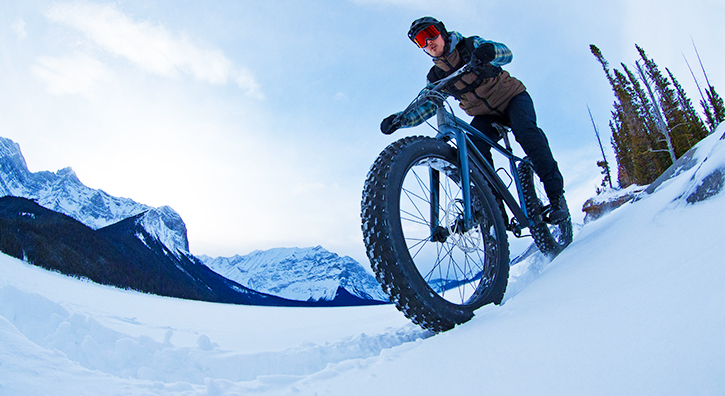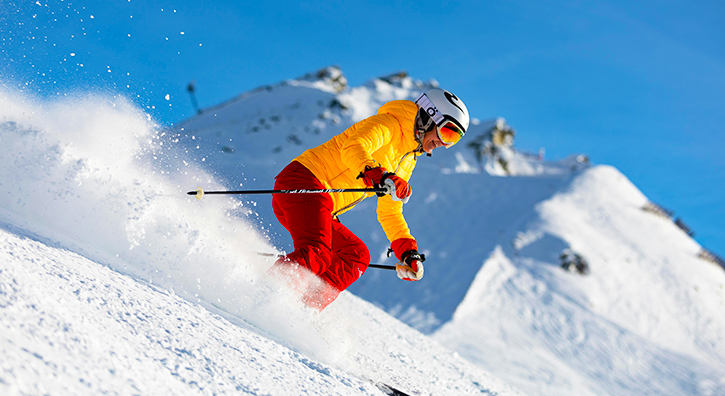0800 260 5082
Available from Monday to Friday from 9am to 7pm, and Saturday from 10am to 7pm. Closed on Sunday.
Available from Monday to Friday from 9am to 7pm, and Saturday from 10am to 7pm. Closed on Sunday.
Fat biking, also known as fat tire biking, is an exciting winter sport that has gained popularity in recent years. It offers the perfect balance of adventure and exercise, making it suitable for riders of all ages and abilities. Whether you're a seasoned mountain biker or someone looking for a new way to explore snowy landscapes, fat biking provides an unforgettable winter experience. Unlike regular mountain bikes, fat bikes are equipped with extra-wide tyres, typically ranging from 3.8 to 5 inches, allowing you to ride over snow and other soft terrain with ease. This makes fat biking accessible to a wide range of riders, from beginners to more experienced cyclists.
The fat biking experience involves riding a specially designed bike over snow-covered trails, taking in the winter scenery while enjoying the thrill of cycling through snow-packed runs. It's an ideal option for anyone looking for a fun and invigorating winter outing. Fat biking allows you to access remote winter landscapes that might otherwise be difficult to reach by foot or skis. Whether you're out for a long ride or a short journey, fat biking offers a chance to embrace the cold while staying active. As a growing travel trend, fat biking is becoming a popular choice for those looking to try something new and unique during their winter travels.
Find out the best destinations for your ski holidays
When selecting the best location for fat biking, look for resorts and trails that offer dedicated routes for fat bike riders. Many mountain resorts and outdoor parks now have specially groomed trails that are perfect for fat biking, providing a smooth ride over snow and ice. These trails are often divided into various levels, from beginner to expert, ensuring that riders of all skill levels can find a route suited to them.
Fat biking is increasingly popular in winter resorts and national parks, where trails are specifically designed to offer scenic views and accessible terrain. Areas like the French Alps and the Nordic regions of Canada provide spectacular snow-covered landscapes, perfect for long rides. The use of fat bikes allows riders to explore areas previously limited to cross-country skiers and snowshoers, offering a new perspective on nature.
Fat biking trails are designed to offer a variety of experiences, from easy, flat trails for beginners to more technical routes for advanced cyclists. Depending on the level of difficulty, these trails may vary in terrain, from wide snow paths to rugged backcountry tracks. Some trails cater specifically to the needs of fat bikers, with smooth, packed snow for a comfortable ride, while others may be more challenging, offering steep inclines and rougher conditions for more experienced cyclists.
The stability of your frame, tyres, and suspension will greatly affect your comfort on different runs. For more technical terrain, a suspension system that can handle bumps, ice, and snow is important for maintaining control. Ensuring that your bike is suited to the conditions of the trail will make a big difference in the ride's overall quality.
Before hitting the trails, it's important to check trail conditions and weather forecasts. Snow conditions can greatly impact the difficulty of the ride, so be sure to confirm that the trails are properly groomed and open for fat biking.

Booking your fat biking experience ahead of time is highly recommended, especially during peak seasons. Many popular destinations require reservations to ensure availability, and it can be especially busy on weekends or during holidays. In addition to booking your session, make sure to check weather conditions, snow reports, and the status of the trails to avoid any surprises on the day of your outing. Fat biking is best enjoyed on fresh snow or groomed trails, so it's important to ensure that the conditions are just right. The traction provided by the wide tires is crucial for maintaining control on the snow, making the right conditions essential for a smooth and enjoyable ride.

For a comfortable and safe fat biking experience, it's essential to dress in layers, especially since you'll be exercising in cold weather. Choose moisture-wicking clothing for the base layer, and add warm, windproof layers on top. Waterproof pants and jackets are also recommended, as fat biking often involves riding through snow and slush, which can leave you wet.
A jersey designed for winter cycling can keep you comfortable and dry while keeping the cold at bay. Layering your clothing is important, as you may sweat during your ride but want to stay warm when stopping for breaks.
While fat biking is generally safe, wearing a helmet is crucial, especially when riding on uneven or challenging trails. It’s also a good idea to wear gloves, knee pads, and elbow pads for added protection. Many resorts or bike shops offer helmets and protective gear as part of the rental service, so be sure to ask if it's available.

When fat biking, it’s important to adjust the pressure in your tyres based on the conditions of the trail. Lowering the pressure allows the tyres to better grip the snow and prevents you from slipping or losing control. Make sure to consult a guide or local shop if you're unsure about the ideal tyre pressure for your ride.

Before heading out, assess your skill level and choose a trail that matches your ability. If you're new to fat biking, start with easy, flat trails and gradually progress to more technical routes as you become more comfortable with the bike and terrain.

Most fat biking locations will have specific safety rules and guidelines to follow. Pay attention to the posted signs, trail maps, and recommendations from resort staff. Some trails may be off-limits during certain weather conditions or when conditions are too difficult, so always stay informed about current trail status.
Always check the weather forecast and snow conditions before heading out for your fat biking adventure. Poor conditions or heavy snowstorms can make trails unsafe or impassable. It’s important to inquire about trail conditions before setting out, and plan your ride accordingly. Also, make sure your bike is in good condition and that your pedal settings are properly adjusted for the terrain. Fat biking is an excellent way to embrace the winter season, whether you're riding solo or with friends and family. It's a thrilling and challenging activity that connects you to the winter landscape in an entirely new way. Get out there and experience the joy of fat biking this winter!